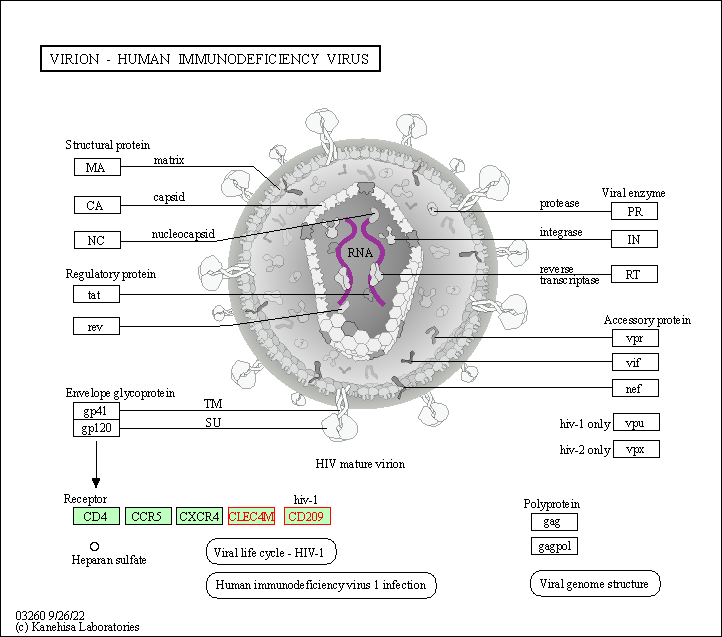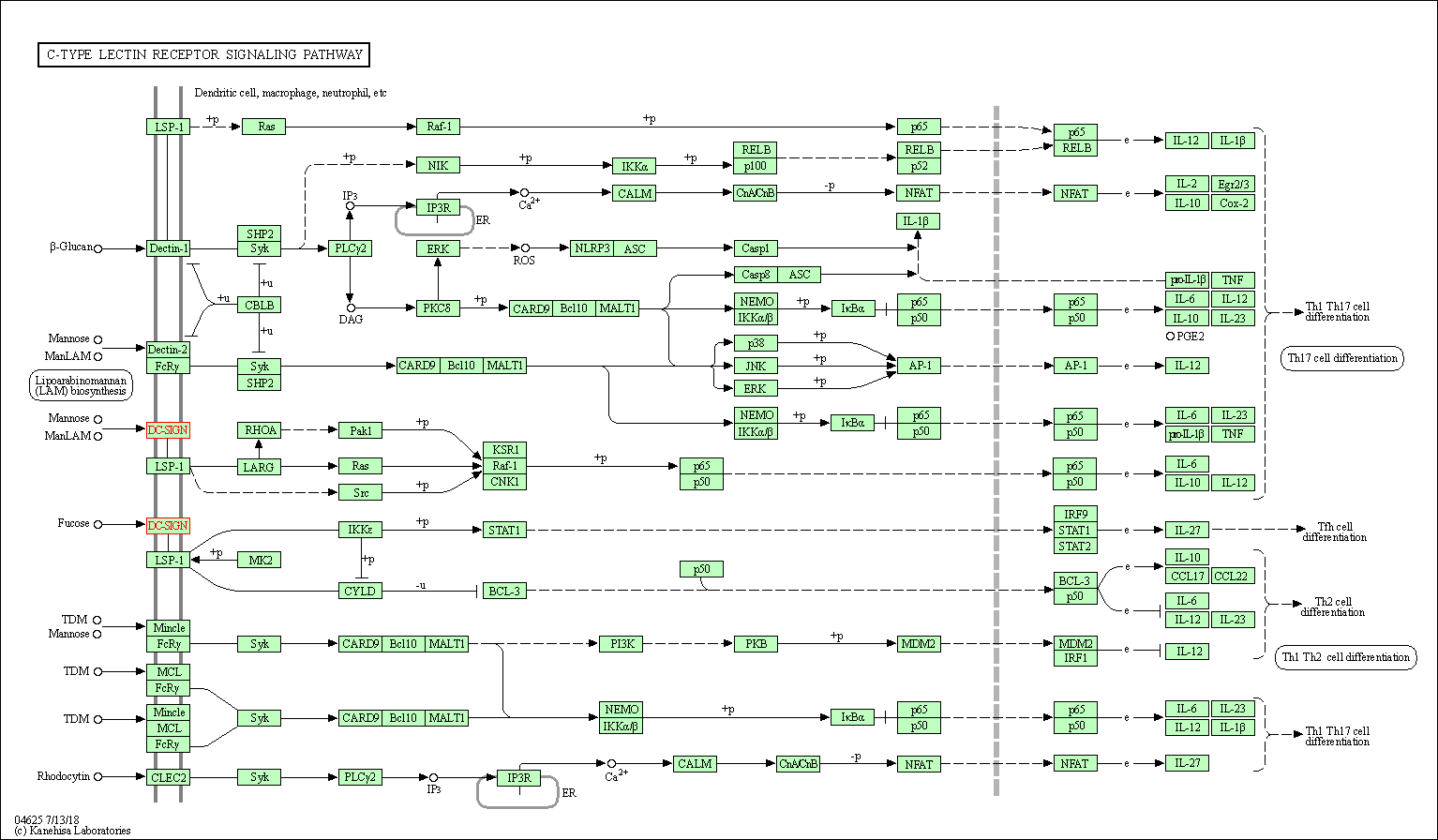Target Information
| Target General Information | Top | |||||
|---|---|---|---|---|---|---|
| Target ID |
T59082
(Former ID: TTDR00854)
|
|||||
| Target Name |
Membrane-associated lectin type-C (CD209)
|
|||||
| Synonyms |
Surface C-type lectin DC-SIGN; Probable mannose-binding C-type lectin DC-SIGN; MDC-SIGN1A type I isoform; Dendritic cell-specific ICAM-3-grabbing nonintegrin 1; Dendritic cell-specific ICAM-3-grabbing non-integrin 1; DC-specific ICAM-3 grabbing nonintegrin; DC-SIGN1; DC-SIGN; CLEC4L; CD209 antigen; CD 209; C-type lectin domain family 4 member L
Click to Show/Hide
|
|||||
| Gene Name |
CD209
|
|||||
| Target Type |
Literature-reported target
|
[1] | ||||
| Function |
Pathogen-recognition receptor expressed on the surface of immature dendritic cells (DCs) and involved in initiation of primary immune response. Thought to mediate the endocytosis of pathogens which are subsequently degraded in lysosomal compartments. The receptor returns to the cell membrane surface and the pathogen-derived antigens are presented to resting T-cells via MHC class II proteins to initiate the adaptive immune response.
Click to Show/Hide
|
|||||
| UniProt ID | ||||||
| Sequence |
MSDSKEPRLQQLGLLEEEQLRGLGFRQTRGYKSLAGCLGHGPLVLQLLSFTLLAGLLVQV
SKVPSSISQEQSRQDAIYQNLTQLKAAVGELSEKSKLQEIYQELTQLKAAVGELPEKSKL QEIYQELTRLKAAVGELPEKSKLQEIYQELTWLKAAVGELPEKSKMQEIYQELTRLKAAV GELPEKSKQQEIYQELTRLKAAVGELPEKSKQQEIYQELTRLKAAVGELPEKSKQQEIYQ ELTQLKAAVERLCHPCPWEWTFFQGNCYFMSNSQRNWHDSITACKEVGAQLVVIKSAEEQ NFLQLQSSRSNRFTWMGLSDLNQEGTWQWVDGSPLLPSFKQYWNRGEPNNVGEEDCAEFS GNGWNDDKCNLAKFWICKKSAASCSRDEEQFLSPAPATPNPPPA Click to Show/Hide
|
|||||
| 3D Structure | Click to Show 3D Structure of This Target | AlphaFold | ||||
| HIT2.0 ID | T59NBL | |||||
| Cell-based Target Expression Variations | Top | |||||
|---|---|---|---|---|---|---|
| Cell-based Target Expression Variations | ||||||
| Drug Binding Sites of Target | Top | |||||
|---|---|---|---|---|---|---|
| Ligand Name: Alpha-D-Mannose | Ligand Info | |||||
| Structure Description | Crystal structure of the complex of the carbohydrate recognition domain of human DC-SIGN with pseudo trimannoside mimic. | PDB:2XR6 | ||||
| Method | X-ray diffraction | Resolution | 1.35 Å | Mutation | Yes | [2] |
| PDB Sequence |
PCPWEWTFFQ
264 GNCYFMSNSQ274 RNWHDSITAC284 KEVGAQLVVI294 KSAEEQNFLQ304 LQSSRSNRFT 314 WMGLSDLNQE324 GTWQWVDGSP334 LLPSFKQYWN344 RGEPNNVGEE354 DCAEFSGNGW 364 NDDKCNLAKF374 WICKKSAASS384
|
|||||
|
|
||||||
| Click to View More Binding Site Information of This Target and Ligand Pair | ||||||
| Ligand Name: Methyl 2-deoxy-2-(4-(pyridine-3-yl))-1,2,3-triazol-1-yl)-alpha-D-mannopyranoside | Ligand Info | |||||
| Structure Description | Crystal Structure of DC-SIGN in complex with a triazole-based glycomimetic ligand | PDB:7NL6 | ||||
| Method | X-ray diffraction | Resolution | 2.20 Å | Mutation | No | [3] |
| PDB Sequence |
CHPCPWEWTF
262 FQGNCYFMSN272 SQRNWHDSIT282 ACKEVGAQLV292 VIKSAEEQNF302 LQLQSSRSNR 312 FTWMGLSDLN322 QEGTWQWVDG332 SPLLPSFKQY342 WNRGEPNNVG352 EEDCAEFSGN 362 GWNDDKCNLA372 KFWICKKSAA382 SC
|
|||||
|
|
||||||
| Click to View More Binding Site Information of This Target with Different Ligands | ||||||
| Different Human System Profiles of Target | Top |
|---|---|
|
Human Similarity Proteins
of target is determined by comparing the sequence similarity of all human proteins with the target based on BLAST. The similarity proteins for a target are defined as the proteins with E-value < 0.005 and outside the protein families of the target.
A target that has fewer human similarity proteins outside its family is commonly regarded to possess a greater capacity to avoid undesired interactions and thus increase the possibility of finding successful drugs
(Brief Bioinform, 21: 649-662, 2020).
Human Tissue Distribution
of target is determined from a proteomics study that quantified more than 12,000 genes across 32 normal human tissues. Tissue Specificity (TS) score was used to define the enrichment of target across tissues.
The distribution of targets among different tissues or organs need to be taken into consideration when assessing the target druggability, as it is generally accepted that the wider the target distribution, the greater the concern over potential adverse effects
(Nat Rev Drug Discov, 20: 64-81, 2021).
Human Pathway Affiliation
of target is determined by the life-essential pathways provided on KEGG database. The target-affiliated pathways were defined based on the following two criteria (a) the pathways of the studied target should be life-essential for both healthy individuals and patients, and (b) the studied target should occupy an upstream position in the pathways and therefore had the ability to regulate biological function.
Targets involved in a fewer pathways have greater likelihood to be successfully developed, while those associated with more human pathways increase the chance of undesirable interferences with other human processes
(Pharmacol Rev, 58: 259-279, 2006).
Biological Network Descriptors
of target is determined based on a human protein-protein interactions (PPI) network consisting of 9,309 proteins and 52,713 PPIs, which were with a high confidence score of ≥ 0.95 collected from STRING database.
The network properties of targets based on protein-protein interactions (PPIs) have been widely adopted for the assessment of target’s druggability. Proteins with high node degree tend to have a high impact on network function through multiple interactions, while proteins with high betweenness centrality are regarded to be central for communication in interaction networks and regulate the flow of signaling information
(Front Pharmacol, 9, 1245, 2018;
Curr Opin Struct Biol. 44:134-142, 2017).
Human Similarity Proteins
Human Tissue Distribution
Human Pathway Affiliation
Biological Network Descriptors
|
|
|
There is no similarity protein (E value < 0.005) for this target
|
|
Note:
If a protein has TS (tissue specficity) scores at least in one tissue >= 2.5, this protein is called tissue-enriched (including tissue-enriched-but-not-specific and tissue-specific). In the plots, the vertical lines are at thresholds 2.5 and 4.
|




| KEGG Pathway | Pathway ID | Affiliated Target | Pathway Map |
|---|---|---|---|
| Virion - Human immunodeficiency virus | hsa03260 | Affiliated Target |

|
| Class: Genetic Information Processing => Information processing in viruses | Pathway Hierarchy | ||
| Virion - Flavivirus | hsa03264 | Affiliated Target |

|
| Class: Genetic Information Processing => Information processing in viruses | Pathway Hierarchy | ||
| Phagosome | hsa04145 | Affiliated Target |

|
| Class: Cellular Processes => Transport and catabolism | Pathway Hierarchy | ||
| C-type lectin receptor signaling pathway | hsa04625 | Affiliated Target |

|
| Class: Organismal Systems => Immune system | Pathway Hierarchy | ||
| Degree | 7 | Degree centrality | 7.52E-04 | Betweenness centrality | 6.57E-05 |
|---|---|---|---|---|---|
| Closeness centrality | 1.93E-01 | Radiality | 1.33E+01 | Clustering coefficient | 1.43E-01 |
| Neighborhood connectivity | 1.14E+01 | Topological coefficient | 1.75E-01 | Eccentricity | 13 |
| Download | Click to Download the Full PPI Network of This Target | ||||
| Chemical Structure based Activity Landscape of Target | Top |
|---|---|
| Target Poor or Non Binders | Top | |||||
|---|---|---|---|---|---|---|
| Target Poor or Non Binders | ||||||
| Target Regulators | Top | |||||
|---|---|---|---|---|---|---|
| Target-interacting Proteins | ||||||
| Target Affiliated Biological Pathways | Top | |||||
|---|---|---|---|---|---|---|
| KEGG Pathway | [+] 3 KEGG Pathways | + | ||||
| 1 | Phagosome | |||||
| 2 | Tuberculosis | |||||
| 3 | Measles | |||||
| Reactome | [+] 1 Reactome Pathways | + | ||||
| 1 | CD209 (DC-SIGN) signaling | |||||
| References | Top | |||||
|---|---|---|---|---|---|---|
| REF 1 | How many drug targets are there Nat Rev Drug Discov. 2006 Dec;5(12):993-6. | |||||
| REF 2 | Unique DC-SIGN clustering activity of a small glycomimetic: A lesson for ligand design. ACS Chem Biol. 2014 Jun 20;9(6):1377-85. | |||||
| REF 3 | Sweet Drugs for Bad Bugs: A Glycomimetic Strategy against the DC-SIGN-Mediated Dissemination of SARS-CoV-2. J Am Chem Soc. 2021 Oct 27;143(42):17465-17478. | |||||
If You Find Any Error in Data or Bug in Web Service, Please Kindly Report It to Dr. Zhou and Dr. Zhang.

